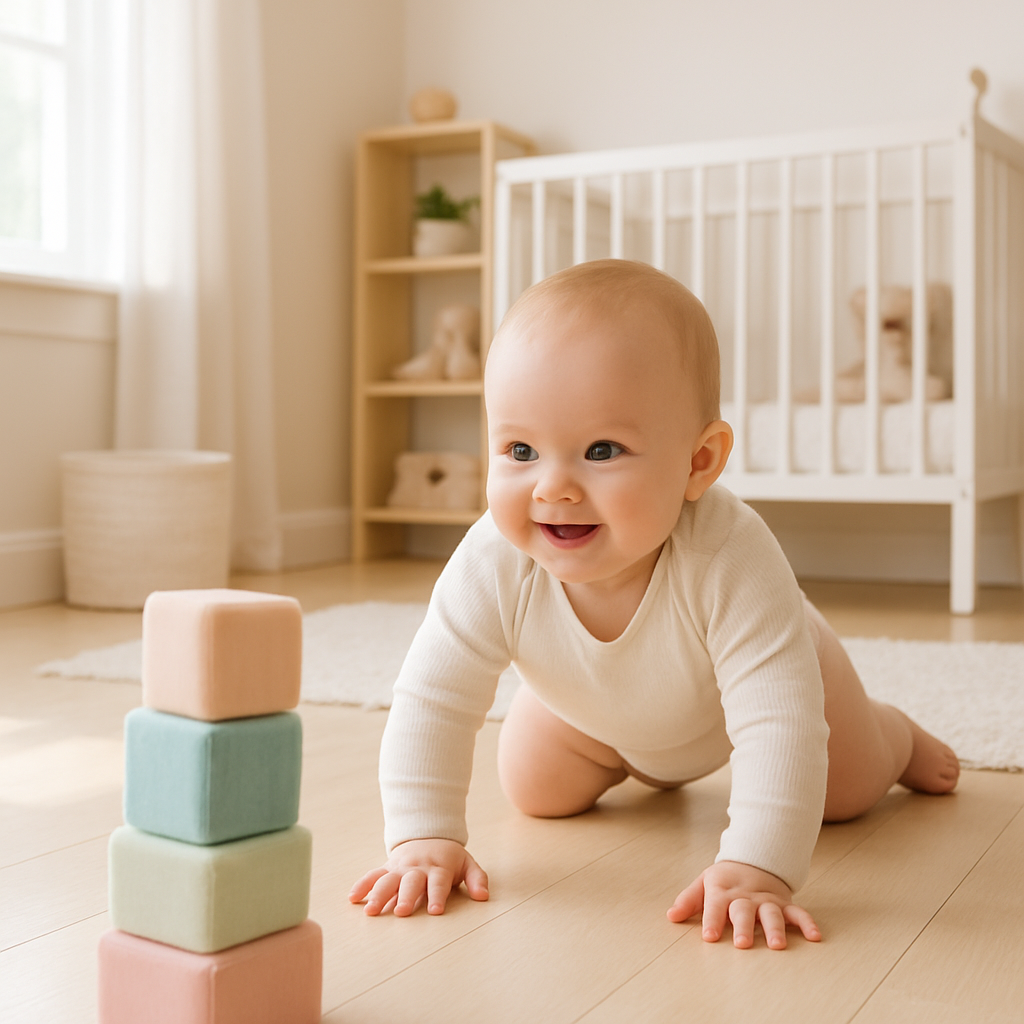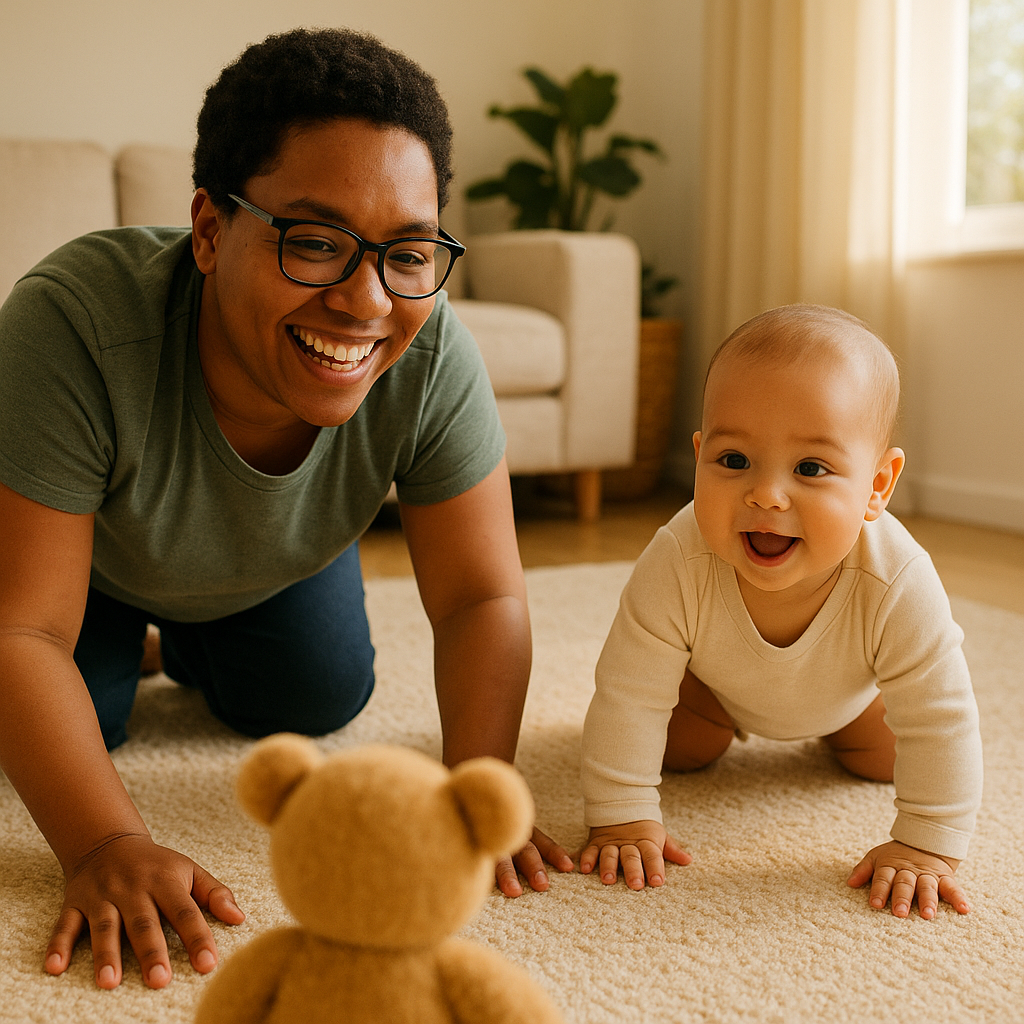Discover the science behind crawling and its impact on your baby’s brain. Learn why it matters, how to encourage it, and what to do if your baby skips this milestone.
Studies show that babies who crawl have 14% less body fat and stronger spatial memory by age 7. Those little shuffles across the floor aren’t just adorable—they’re a brain-building workout. Every time your baby rocks on hands and knees, billions of neurons connect, linking muscles, senses, and curiosity into a network that lasts a lifetime.
Crawling is your baby’s first big step in movement, and it does wonders for their brain and body. Dive in for more!
- Why does crawling matter more to the brain than to the knees?
- How do cross-lateral movements during crawling “wire” the corpus callosum?
- Which sensory systems light up when babies crawl across carpet, tile, or grass?
- How does crawling pave the way for handwriting, speech, and school readiness?
- What if my baby skips crawling—should you worry?
- How can parents safely encourage brain-boosting crawling every day?
- What gaps remain in crawling research?
- Your Top Questions, Answered
- Final Thoughts
Why does crawling matter more to the brain than to the knees?
Crawling is your baby’s first full-body workout, powering up their brain more than their knees. The cross-lateral motion—opposite arm and leg moving together—boosts communication between brain hemispheres via the corpus callosum, strengthening neural pathways. See Corpus Callosum Development. This helps skills like problem-solving and coordination.
Crawling also builds muscle control for future tasks like holding a crayon, thanks to weight-bearing on palms and core as in Fine Motor Skills. It supports myelination, speeding up brain signals, and may help integrate reflexes linked to learning challenges. Crawling engages senses—touch, balance, and vision—enhancing spatial awareness as studied in Spatial Memory.
Unlike scooting, hands-and-knees crawling maximizes brain benefits. For more on that hand-to-mind link, visit Fine Motor Skills: Boosting Your Baby’s Brain Power.

How do cross-lateral movements during crawling “wire” the corpus callosum?
Cross-lateral movements during crawling—where the right arm and left leg (or vice versa) move together—play a key role in strengthening the corpus callosum, the brain’s “bridge” connecting its two hemispheres. Each time your baby crawls, electrical impulses zip across this bundle of nerve fibers, linking areas for vision, hearing, and movement. This process supports myelination, where nerve fibers gain a protective coating to speed up signals as noted in Normal Myelination. Research suggests such movements enhance brain connectivity, aiding skills like reading and note-taking later. Crawling also helps integrate primitive reflexes, potentially reducing learning challenges.
Curious about the full milestone timeline? See Gross Motor Milestones: Supporting Your Baby’s Brain.
Which sensory systems light up when babies crawl across carpet, tile, or grass?
When babies crawl across surfaces like carpet, tile, or grass, multiple sensory systems activate, enriching their brain development:
- Tactile System: Palms and knees touching varied textures (soft carpet, cool tile, prickly grass) sharpen touch sensitivity and body awareness, reducing tactile defensiveness later.
- Proprioceptive System: Pressure through joints and muscles during crawling helps babies understand their body’s position in space, building coordination.
- Vestibular System: Head tilts while crawling recalibrate inner ear sensors, enhancing balance for future walking.
- Visual System: Shifting focus from hands to distant objects trains binocular vision and depth perception, boosting spatial skills as noted in Infant Spatial Memory.
Research shows crawlers spend 54 % of their movement time scanning the floor—practice linked to better peripheral vision in preschool. Exposure to varied textures also reduces tactile defensiveness later in childhood.

How does crawling pave the way for handwriting, speech, and school readiness?
Crawling builds three essential foundations for school success:
- Shoulder and Wrist Stability: Weight-bearing on palms strengthens muscles needed for pencil grip, self-feeding, and buttoning.
- Eye Tracking: Moving left-to-right while crawling mimics reading patterns, easing literacy development.
- Core Strength: A strong core supports breath control, helping toddlers speak in longer, clearer sentences.
Crawling also activates the prefrontal cortex, enhancing memory and focus for kindergarten tasks like working memory, impulse control, and flexible thinking. Read more on: Prefrontal Cortex in Infancy.Try these floor games from 5 Baby Exercises to Boost Brain Development to keep the momentum going.
What if my baby skips crawling—should you worry?
Not all babies crawl, and that’s often fine—some scoot or roll and still develop well. The key is symmetrical movement by 10 months. Red flags include one-sided movement, no arm weight-bearing, or no mobility by 11 months—consult a pediatrician if you notice these. “Retro-crawling” through tunnels can spark brain pathways for walkers. In cultures with extensive baby-wearing, crawling may start later, but floor time helps catch-up. For example, a pillow obstacle course makes it fun. Learn more at How Physical Activity Boosts Your Baby’s Brain.
How can parents safely encourage brain-boosting crawling every day?
To spark brain-boosting crawling, try this daily routine:
- Floor Time: Offer three 10-minute sessions on varied surfaces like yoga mats or grass to engage senses.
- Motivation: Place fun toys, like a musical turtle, just out of reach to encourage movement.
- Limit Containers: Keep swings or walkers to under 15% of awake time to prioritize floor exploration.
- Model Crawling: Get down and crawl with your baby; mirror neurons fire when they copy you.
For example, set up a safe “crawl zone” with soft toys to make it fun. These steps help wire your baby’s brain for learning and coordination.

What gaps remain in crawling research?
Crawling’s role in infant development shows promise, but key research gaps persist. Long-term studies following non-crawlers beyond age 10 are needed to assess lasting impacts on cognitive and motor skills. Data from cultures with limited floor time, where baby-wearing is common, could clarify how alternative movements like scooting or rolling compare to crawling’s brain-boosting effects. Additionally, more research on premature babies would help tailor guidance for their unique developmental needs, as current studies often focus on typically developing infants. Understanding these areas would empower parents to support their baby’s growth effectively, especially in diverse or atypical scenarios. Parents of preemies can explore tailored guidance in Premature Baby Brain: Helping Your Preemie Thrive.
Your Top Questions, Answered
-
When do most babies start crawling?
Typically between 6 and 10 months. Any symmetric self-propulsion by 10 months is the key milestone. -
Is belly-crawling enough?
Great first step, but encourage hands-and-knees next. The cross-body rhythm delivers the biggest brain payoff. -
Can extra tummy time replace crawling?
Tummy time builds strength but lacks cross-body motion—use both. -
Should I stop crawling games once my baby walks?
No. Crawling after walking continues to refine brain wiring; tunnels and obstacle courses make it fun. -
Does crawling reduce the risk of learning problems?
Evidence points that way. Crawling helps inhibit primitive reflexes tied to reading and attention challenges, though it’s one of many factors.
For myth-busting about unrelated worries, see Vaccines and Baby Brain: Debunking Autism Myths.
Final Thoughts
Crawling is a multitasking marvel—strengthening muscles, linking brain hemispheres, fine-tuning senses, and laying groundwork for reading, writing, and healthy metabolism. Clear a safe patch of floor, cheer on those wiggles, and explore more milestones in our Gross Motor Milestones guide. Every crawl you celebrate today echoes as confidence and curiosity tomorrow.